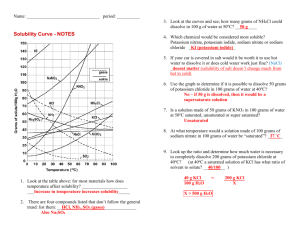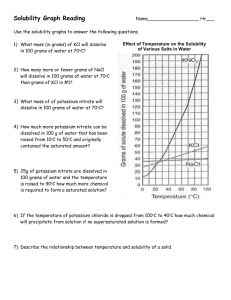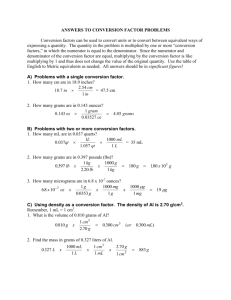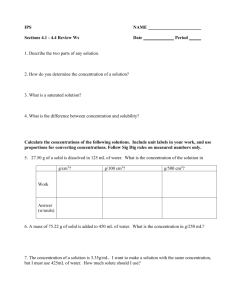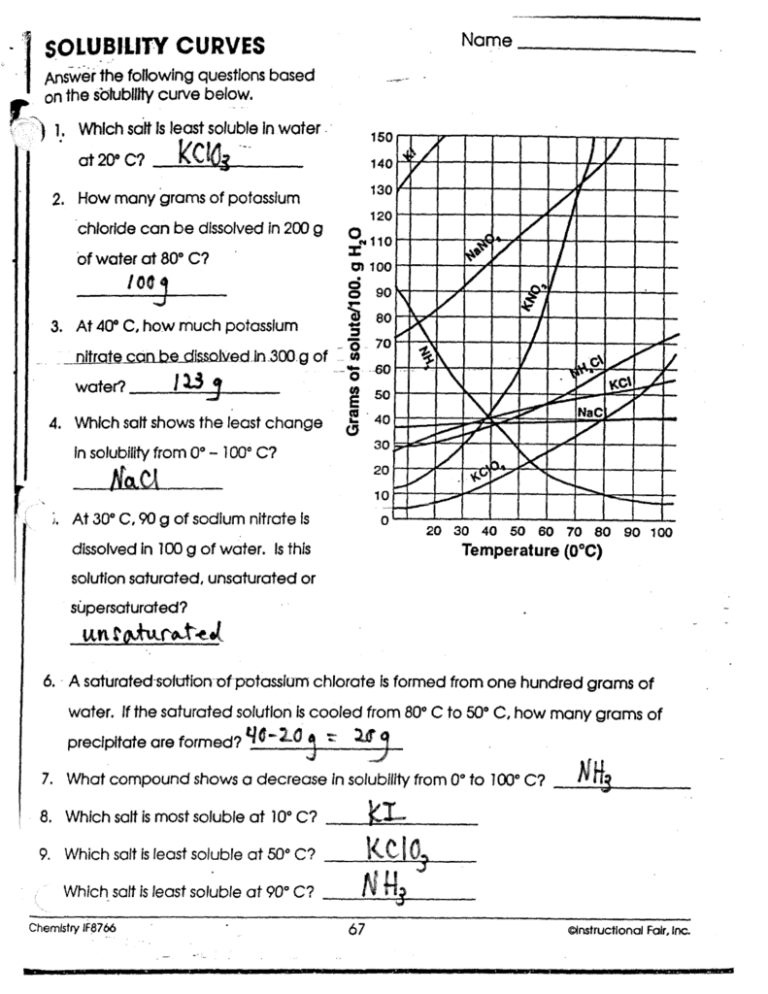
Name
SOLUBILITY CURVES
Answer the following questions based
on the solubility curve below.
Which salt is least soluble in water ..
at 2O° C?
2. How many grams of potassium
chloride can be dissolved in 200 g
of water at 80° C?
IO
3. At 40° C, how much potassium
_ __nitrate coin be dissoiu$tl ^n 30D.g of
water?
------W-
'1
80
70
...- O --60
0 5©
40
4. Which salt shows the least change
30
In solubility from 0° - 100° C?
20
10
At 30° C, 90 g of sodium nitrate Is
0
20 30 40 50 60 70 80 90 100
Temperature (0 °C)
dissolved in 100 g of water. Is this
solution saturated , unsaturated or
supersaturated?
tat r
6. A saturated-solution-of-potassium chlorate is formed from one hundred grams of
water. If the saturated solution is cooled from 80° C to 50° C, how many grams of
precipitate are formed?
- -0 'I
4-V I
7. What compound shows a decrease in solubility from 0° to 100° C?
8. Which salt is most soluble at 10° C?
9. Which salt is least soluble at 50° C?
Which salt is least soluble at 90° C?
Chemistry IF8766
67
®instructlond Fair. Inc.
Date
Name
CHAPTER 16 REVIEW ACTIVITY
Class Text Reference : Section 16-9
Solubility Curves
Study the solubility curves in the figure , and then
answer the questions that follow.
1. What relationship exists between solubility
and temperature for most of the substances
shown?
2. a. What is the exception?
NN t i
b. What general principle accounts for this ex6
6"
ception?
3. a. Approximately how many grams of NaNO3
will dissolve in 100 g of water at 20°C?
b. How many grams will dissolve at 60°C?
L How many grams of NHgC1 will dissolve in
= R.
1 dam'- of H2O at 50°C?
o
5. Ninety grams of NaNO3 is added to 100 g of H2O
at 0°C. With constant stirring, to what temperature
C must the solution be raised to produce a saturated
solution with no solid NaNO3 remaining?
6. A saturated solution of KC103 was made with
300 g of H2O at 40°C. How much KCIOa could be
recovered by evaporating the solution to dryness?
7. Five hundred grams of water is used to make a
^saturated solution of KCI at 10°C. How many more
grams of KCI could be dissolved if the tem„ perature were raised to 100°C?
8. A saturated solution of KNO3 in 200 g of H2O at
50°C is cooled to 20°C. How much KNO3 will precipitate out of solution?
COPYRIGHT by Prentice Hall, Inc.
Reproduction of this master is restricted to duplication for classroom use only.
CHEMISTRY: The Study of Matter
16-11
SCIENCE
' Solubility Calculations
1. Calculate the maximum number of grams of each solute that can be dissolved;
b) sodium chloride in 1250 um3
c) sodium nitrate in 50 crag
a) potassium nitrate in 300 cm3
of
water
at
400
C.
of water at 0° C.
of water at 80° C.
X
H7
3
2. Calculate the minimum volume of water needed to dissolve;
b) 10.0 g of potassium nitrate
a) 500 g of sodium chloride
in water at 0° C.
in water at 100° C.
c) 1.00 kg of sodium nitrate
in water at 50° C.
x
3. Calculate the temperature the water must be to just dissolve;
a) 80.0 g of potassium nitrate
in 200 cm3 of water.
b) 60.0 g of potassium nitrate
in 50 cm3 of water.
X
4. Calculate the mass of precipitate in each case below;
a) a saturated solution of sodium nitrate
in 400 cm3 of water at 100° C is made.
The temperature i s then changed to 13° C.
c) 500.0 g of sodium nitrate
in 500 cm3 of water.
a<
b) a saturated solution of potassium nitrate
in 250 cm3 of water at 80° C is made.
The temperature is then changed to 8° C.
w,
3. The dissolving of both salt and sugar involves the solid separating into particles too small to see. The salt solution
contains ions of sodium and chlorine and will conduct a current, while the sugar dissolves to release sugar molecules,
so its solution will not conduct electricity.
Try This Activity: Substances i n Water
(Page 265)
(a) The potassium permanganate, sugar, and ethanol dissolve.
(b) Sugar and ethanol are certainly soluble, as they disappear completely. The solubility of potassium permanganate is
less certain, as some of it remains undissolved.
Note: Students may be uncertain about any substance that does not "disappear" completely upon dissolving, because
they rarely encounter this. Expect discussion about potassum permanganate, if they had some remain in solid state.
Students may be uncertain if they speculate about whether some calcium carbonate or vegetable oil dissolves, even
though there is no visible reduction of the original phase. They have only visible evidence of sample "shrinking" to
go on, where no colour change is involved.
(c) The calcium carbonate and vegetable oil do not dissolve.
(d) We cannot be entirely certain, as a small amount may have dissolved.
(e) Properties are different: solutions are visibly homogeneous. Some other properties that might differ include electrical
conductivity, acidity, melting/freezing points, viscosity, and so forth.
(f) Acidity could be tested with pH paper or conductivity with a multimeter.
Note: Tests listed by students should be consistent with their answers to (e).
PRACTICE
(Page 269)
Understanding Concepts
(a) Heterogeneous: different substances are visible.
(b) Homogeneous: only one phase is visible.
(c) Homogeneous if it has been decanted; if not, there may be sediment in the bottle and the red wine would then be
considered heterogeneous.
(d) Heterogeneous if corroded; if clean, bronze appears homogeneous.
(e) Homogeneous: the metal looks all the same throughout.
(f) Heterogeneous if corroded; otherwise it is homogeneous.
(g) Humid air is usually homogeneous; however, when cloud, fog, or rain forms, the solution is heterogeneous.
(h) Heterogeneous: the suspended droplets of water make it opaque.
(i) Heterogeneous: the water is not clear.
2. The solutions are (b), (d), (h) and (i).
1.
(a), (c), (e), (f) and (g) are not solutions.
Solutions may be classified by type of solvent, by electrical conductivity, by acidity, by colour, or by physical state at
room conditions. Even categories such as viscosity, volatility, etc., can be used to classify substances.
4. (a) An aqueous solution is one in which the solvent is water.
3.
(b) Aqueous solutions found around the home will be substances such as shampoo, vinegar, syrup, clear fruit juices,
tea, bleach, drain cleaners.
5. Methanol is a nonelectrolyte (it is a nonacidic molecular substance); sodium chloride is an electrolyte (it dissolves to
release ions); hydrochloric acid is an electrolyte (acids are the only molecular substances to conduct electricity); and
potassium hydroxide is an electrolyte (it is ionic),
6. (a) Electrolyte solutes include soluble ionic compounds (including ionic hydroxides) and acids.
(b) electrolyte: a substance that dissolves in water to form a conducting solution
7. (a) Acidic solutions have acid solutes.
(b) Basic soutions have ionic hydroxide solutes.
(c) Neutral solutions have molecular solutes (other than acids) or ionic solutes (other than ionic hydroxides).
8. (a) Electrolytes: citric acid, salt (assume sodium chloride), sodium citrate, and monosodium phosphate (4 of the 11.
substances listed).
Copyright © 2002 Nehson Thomson Learning
Chapter 6 The Nature and Properties of Solutions
165
1)
How many grams of potassium carbonate are needed to make 200 mL of
a 2.5 M solution? 69.1 grams
2)
How many liters of 4 M solution can be made using 100 grams of lithium
bromide? 3.47 L
What is the concentration of an aqueous solution with a volume of 450 mL
that contains 200 grams of iron (11) chloride? 3.51 M
4)
How many grams of ammonium sulfate are needed to make a 0.25 M
solution at a concentration of 6 M? 171.2 grams
5)
What is the concentration of a solution with a volume of 2.5 liters
containing 660 grams of calcium phosphate? 0.85 M
6)
How many grams of copper (11) fluoride are needed to make 6 . 7 liters of a
1.2 M solution ? 1081.4 gams
7)
How many liters of a 0. 88 M solution can be made with 25. 5 grams of
lithium fluoride? 1.11 L
8)
What is the concentration of a solution with a volume of 660 mL that
contains 33.4 grams of aluminum acetate? €0,25 M
9)
How many liters of a 0.75 M solution can be made with 75 grams of lead
(ll) oxide? 12.6 grams
10)
How many grams of manganese (IV) oxide are needed to make 5.6 liters
of a 2 . 1 M solution ? 1021.9 crams
11)
What is the concentration of a solution with a volume of 9 mL that
contains 2 grams of iron (Ill) hydroxide? 2.08 M
12)
How many liters of a 3.4 M isopropanol solution can be made with 78
grams of isopropanol (C3HgO)? 0,41 L
13)
What is the concentration of a solution with a volume 3.3 mL that contains
12 grams of ammonium sulfite? 31.3 M
For chemistry help, visit www.chemfiesta.com
012000 Cavalcade Publishing, All Rights Reserved

